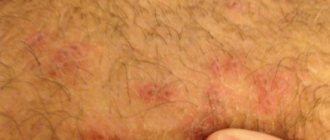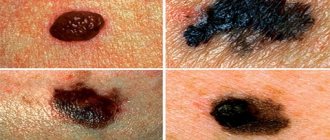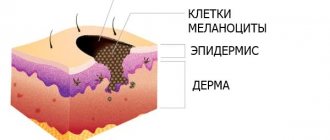Moles after sunburn are formations that arise after exposure to ultraviolet radiation; they can only create a cosmetic defect, but sometimes they signal serious problems. Almost every person on the planet is familiar with moles. They can be congenital or acquired. In most cases, an increase in the number of nevi occurs after exposure to direct sunlight.
Why do many moles appear after sunbathing?
Sunbathing is beneficial, it helps restore the body, increases performance and serves as a source of vitamin D - that’s what doctors say. But at the same time, they warn that after getting a tan, you can discover a lot of new and interesting things on your skin. In particular, moles (nevi) can form - sometimes they are single, but often they form “in a cluster”, in small islands at once.
The cause of the appearance of moles after sunbathing is the direct effect of sunlight (ultraviolet) rays on the skin. The pigment melanin is actively produced and if it is distributed unevenly in the layers of the epidermis, moles or dark spots form.
If a person has sunbathed correctly, then the likelihood of new moles appearing is negligible, but even a slight excess of time spent in direct sunlight becomes a “push” for this process.
We recommend reading the article about tanning after mole removal. From it you will learn about why you should not sunbathe immediately after removing a mole, when you can after laser excision, whether it is worth removing a mole if you plan to tan, and recommendations for visiting the beach. Read more about brown spots after sunbathing here.
Removal methods
If the doctor decides to remove moles that appeared after a solarium or tanning in the sun, then this can be done in the following ways:
- Surgical removal . The oldest method that leaves noticeable marks on the skin after the procedure. It is used only in extreme cases when the use of more modern technologies is impossible for good reasons. An imperfect method that severely injures the skin.
- Radio knife . Non-contact method with minimal risk of infection. The wound heals quickly and does not require increased monitoring. Used for shallow tumors.
- Laser removal is a modern and fast way to get rid of tumors and skin defects. Advantages of using laser technology: speed, accuracy, lack of inflammation, deep removal. The laser-treated area finally heals and is compared with the general surface within two months. Before the procedure, a doctor's consultation is required to make sure that the skin growth is not malignant.
These are the ways to get rid of a mole that appears after sunbathing. The attending physician will determine which method is suitable for a particular patient.
It has been proven that excessive exposure to the sun provokes the growth of tumors on the skin, as well as the degeneration of existing ones into malignant ones. Therefore, you need to be careful.
Some countries have particularly high rates of malignant neoplasms. For example, in sunny countries - the USA (in some states) and Australia. Residents of northern countries, who spend much less time in the sun, should not relax either. In Russia, active prevention of melanoma is also underway.
It is important to follow simple rules for sunbathing: appear in the sun only during safe morning and evening hours, stay in the sun for no more than two hours, avoid redness and sunburn, take a shower before tanning sessions after swimming in salt water, use cosmetics to protect against uv rays.
It is necessary to regularly examine your skin or ask loved ones for help with this procedure. If suspicious tumors appear, immediately go to the doctor. If necessary, immediately remove moles that cause discomfort or pose a serious threat to health. It should be remembered that prevention and compliance with recommendations will help avoid resorting to painful surgical procedures.
Causes of new red spots on the back and other parts of the body
Most often, new moles after sunbathing have the usual brown-golden hue and are no different from those that are congenital formations. But the appearance of distinctly red moles is often observed almost immediately after sunbathing. And most often this happens on the back, less often on other parts of the body.
Red moles are hemangiomas that are formed from tiny blood vessels. After tanning, they appear only if exposure to sunlight was too aggressive or prolonged. In most cases, they do not pose a danger to human health and life, but require observation.
If a red mole begins to increase in size or ulcers or erosions appear on its surface, then you need to consult a doctor - there is a high risk of the formation transforming into a malignant disease.
Is it true that the sun can cause spots?
The mole (nevus) is dark brown to brown in color due to the presence of the pigment melanin. Moles appear small, in the form of a small speck, then they can become larger or even rise above the skin. By their nature, nevi are not dangerous, although they are a benign neoplasm. But under the influence of ultraviolet radiation, they can change size, shape, spread throughout the body, but what is more dangerous is the ability to transform into a low-quality tumor. Excessive exposure to the sun, the sea, or near a body of water can contribute to this. This dangerous formation is called melanoma. It is 60% of all melanomas that appear after excessive sun exposure.
Why do moles change after sunbathing?
If immediately after sunbathing moles appear in their usual “appearance,” then after some time they may change. And it is important not to miss this moment, because it can signal serious health problems.
Blushed
Most often this occurs due to injury to the mole - rubbing with clothing, while washing with a washcloth, or when scratching (itching of the skin). Usually, in this case, not only the formation turns red, but also the skin around it, bruises and small hematomas may appear.
If a person continues to sunbathe despite already formed nevi and an existing tan, then the redness may be associated with a sunburn. Skin hyperemia will be diffuse, without clearly defined contours. Also, the change in question can occur while taking hormonal medications - for example, if a woman constantly takes oral contraceptives.
A condition is considered dangerous when redness appears not on the “body” of the nevus itself, but around it. This may indicate that the tumor has degenerated into a malignant tumor, so consultation with a doctor is required. Only specific dermatological studies can confirm or refute the diagnosis.
Increased
If, some time after sunbathing, moles begin to increase in size, this can happen for the following reasons:
- the person continues to be in direct sunlight;
- pregnancy;
- adolescence (due to hormonal fluctuations);
- diseases of the thyroid gland, regardless of whether the production of hormones by the organ has increased or decreased.
Dermatologists recommend not to neglect the symptom of enlargement of moles after sunbathing, because this may mean the degeneration of their cells into malignant ones. This is a sign of the development of melanoma, but according to statistics, this happens if the expansion of the boundaries of the nevus is directly related to its injury.
Itchy
Itchy skin after sunbathing is a natural reaction of the body to the aggressive effects of ultraviolet rays.
Newly appearing moles are also the consequences of sunbathing, so we can assume that they may itch for natural reasons:
- keratinized particles are peeled off from the surface of the epidermis;
- an allergic reaction to the sun appears;
- the skin in a particular area has become excessively dry;
- inadequate reaction of the skin to cosmetics, sunscreens (if any were used).
As a rule, the itching of the mole goes away after 2-3 days. To alleviate the condition, it is worth lubricating it with a solution of table vinegar, which is prepared with water in equal proportions. It is also recommended to take antihistamines these days - Suprastin, Tavegil, Ceterizin.
If within 3 days the unpleasant symptom does not disappear, additional pain appears or the mole begins to bleed, then this is a reason to contact a dermatologist - perhaps processes of degeneration into malignant ones are taking place in the formation cells.
They hurt
In general, moles do not hurt and this symptom should alert a person. If the formation appears after sunbathing and after a while it begins to bother you with its pain syndrome, then there may be several reasons for this:
- the harmful effects of sunlight on a specific problem area continue - a sunburn occurs, for which pain is a classic symptom;
- the nevus was injured - scratching, careless handling of a washcloth during water procedures, the use of scrubs, too tight and tight clothes, and so on;
- rapid growth of a mole - this leads to overstretching of the skin, which provokes the presence of pain.
Inflammation may also occur at the site of a newly appeared mole - for example, against the background of a dermatological disease or infection after injury. Doctors rarely associate painful sensations with the degeneration of a mole into melanoma; in this case, they are usually combined with active growth, darkening and bleeding.
There is a white halo, a spot around
The appearance of a white spot around the nevus is the most harmless thing that can happen. Most often, this phenomenon is associated with the presence of vitiligo, a disease associated with a deficiency of the melanin pigment in the cells of the dermis. Such whitish spots may have an irregular shape, lack borders/contours, and in some cases look like a swelling over the general surface of the body.
White spots around the mole do not need any treatment, they disappear on their own, but after some time - a month or six months may pass.
Risk group
People at risk include:
- with blond or red hair;
- with white skin;
- with light eyes;
- who burns very quickly from the sun;
- adults who received a lot of sunburn in childhood;
- men over 50 years of age;
- if there have been cases of melanoma in the family.
To minimize the risk, it is important to use sunscreen every day before going outside. Avoid prolonged exposure to heat and wear protective clothing. It is extremely important to prevent the appearance of moles in advance. It is worth visiting a dermatologist once a year to check the condition of moles, regardless of the risk group. In people with dark skin, it is more difficult to detect the disease early.
The main cause of malignant tumors is ultraviolet radiation, which damages melanocytes and thereby provokes disturbances in the functioning of the body's immune system. A decrease in the protective function of the immune system provokes the chaotic development of dye cells, which is fraught with the appearance of a tumor.
After tanning in the sun, people with white skin are more likely to develop new nevi. Moles also appear due to hormonal imbalances in the body, which are pronounced during puberty, pregnancy or menopause. But during such periods, spots can either appear or disappear without a trace.
The risk of developing new nevi remains in people whose skin is rich in melanin. A person with dark skin is not so exposed to the dangerous effects of radiation. The danger remains for people with light skin.
The time it is safe to spend on the beach is influenced by the person’s skin type and predisposition. Albinos often experience burn lesions and excessive formation of condylomas. It's actually dangerous. Under the aggressive influence of radiation, albinos remain at high risk of developing cancer.
People living in areas with increased solar activity often develop skin cancer. Residents of hot countries often suffer from cancer. This fact is influenced by skin type, sun aggressiveness and time spent under it. Compliance with the basic rules of being on the beach and in conditions of elevated temperature reduces the likelihood of complications.
The danger of moles changing after sunbathing
For the most part, moles formed after sunbathing do not pose a threat to human health and life. But in some cases, in the presence of favorable factors, they can degenerate into a malignant disease - melanoma. Changes in moles such as:
- rapid increase in size;
- bleeding for no apparent reason;
- change in the shade of the surface of the nevus (may become light, interspersed with red, pronouncedly dark/almost black);
- loss of clear contours
should alert a person and become a reason to contact a dermatologist. Moreover, experts say that not only newly formed moles can undergo such changes in appearance, but also those that have been on a person’s skin for many years - this can be the effect of a passion for sunbathing.
Complications
Nevi are areas of melanin accumulation that react to the sun quite quickly and painfully. Prolonged exposure to the sun can subsequently provoke serious complications such as skin cancer.
The main signs of a mole transforming into melanoma:
- irregular shape and uneven contours;
- polychromy (the color of the formation consists of several shades at the same time, light gray, light brown to deep dark and black);
- the size of the neoplasm is more than 5 mm;
- itching, bleeding, redness, cracks in moles.
To protect yourself from the danger of malignant degeneration, you need to carefully monitor the appearance of moles.
Signs of degeneration into melanoma
Nevus cells transform into malignant ones very slowly - this is a problem for diagnosticians, because melanoma is usually detected in the later stages of development. The person himself must take care of his health and monitor newly appeared and existing moles, especially if there is a factor of exposure to direct sunlight. There are a number of signs that indicate cell malignancy:
- the surface of the formation is uneven, “clumsy”, rough;
- there is pronounced redness around the nevus;
- the mole bleeds periodically;
- Itching is disturbing, and pain often appears.
Regarding the increase in the size of the mole, the opinion of doctors is ambiguous. The fact is that this sign of melanoma formation cannot be classified as diagnostic - the size of the nevus can increase either quickly or extremely slowly.
What symptoms should you see a doctor for?
In order to detect the development of a dangerous disease in time, it is necessary to consult a doctor in a timely manner. Suspicion should be raised by the following symptoms:
- pain when touched;
- inflammatory processes;
- education began to grow rapidly;
- the skin around the area has become red;
- swelling;
- itching;
- small moles appeared around;
- the nevus has divided into several parts;
- periodic bleeding;
- The color of the birthmark changed from brown to black.
A timely visit to a doctor will allow you to identify the disease at an early stage and carry out relevant treatment. The listed signs cannot be ignored. It must be remembered that melanoma is a particularly aggressive cancer with active metastasis, it is difficult to treat in advanced stages, and gives a disappointing prognosis.
Moles that appear after sunbathing are not only a cosmetic defect. They can provoke the development of a dangerous condition. A person needs to provide maximum skin protection during periods of solar activity. If additional moles appear after sunbathing, you should visit a doctor.
Measures to prevent the degeneration of moles after sunbathing
Sunbathing should be done wisely and not chase a chocolate tan on the very first day of your stay at the beach. If this process is “built” correctly, then the risk of degeneration of nevi after tanning into malignant formations can be reduced to zero.
Here's what dermatologists and oncologists recommend:
- if a person’s skin is too light and prone to burns, then sunbathing is generally extremely undesirable for him, but there is an option to use the most powerful sunscreens;
- exposure to direct sunlight should be limited in time - two hours in the morning (from 9-00 to 11-00) and the same amount in the evening (from 16-00 to 18-00);
- even if the weather is cloudy, you still need to protect your skin from the harmful effects of ultraviolet rays - it has been proven that high cloudiness does not deter them and does not reduce aggressiveness;
- when going outside on a sunny day, you need to dress in closed suits/dresses, but made of light fabrics; wearing a headdress is mandatory;
- Regardless of skin type, when going to the beach to get a tan, you need to use sunscreen cosmetics.
And of course, you need to subsequently monitor the condition of all moles on the body and face. Even minor changes in their size, color or structure should immediately seek help from specialists.
We recommend reading the article about the effects of the sun on the skin. From it you will learn about the effect of the sun on human skin, why it is so important to protect the face, the effect of wind on the dermis, and also how to protect it from UV rays. And here is more information about whether self-tanning is harmful.
Moles after sunburn can appear anywhere, but more often they occur on those areas of the body and face that have been exposed to direct sunlight. Initially, they do not pose any danger to humans, but must be constantly monitored. In this case, it will be possible to timely detect the onset of degeneration of moles into melanoma and prevent the spread of the malignant process.
Rules
The question arises: will I really have to give up tanning? Of course, you can sunbathe, but always in moderation.
Those who have few moles should remember that large doses of ultraviolet radiation are harmful for them, especially since under the influence of UV rays new moles appear, sometimes in large quantities.
- You need to avoid being under the sun from 10 a.m. to 4 p.m., because tanning is quite harmful during these hours. When going outside at this time, you should wear long sleeves and a Panama hat.
- After swimming in the sea, you must rinse with fresh water and dry your body thoroughly. Because salt water enhances the effect of ultraviolet radiation.
- For people with high blood pressure, problems with the cardiovascular system, and fair skin, it is advisable to minimize sun exposure.
- Those with a large number of moles, especially large ones, should not sunbathe under open rays. After swimming, you need to dry yourself with a towel, cover moles with clothes and sunbathe under an umbrella.
- Before tanning, it is recommended to apply sunscreen to your skin. To some extent, it will protect the skin and moles from exposure to radiation. You need to choose a cream based on your skin type, the degree of existing tan and the duration of sun exposure. However, it should be remembered that none of the products protects moles from ultraviolet radiation 100%.
What to do if moles start to appear in the groin?
Is it dangerous to remove moles using electrocoagulation? Details here.
When is it contraindicated to remove moles with celandine? Read here.
Some believe that you can protect moles from ultraviolet radiation with the help of a patch (sealing nevi).
- Yes, the rays will not penetrate through the patch, but fresh air will not penetrate either.
- At elevated temperatures and lack of ventilation, moisture will begin to collect under the patch, and as a result, the mole will be subject to an undesirable greenhouse effect.
- In addition, the patch can injure the mole, which will also cause harm to it.
Useful video
Watch the video about why new moles appear on the body:
Similar articles
- How long does redness last after tanning
? How long redness lasts after tanning is influenced by two factors - individual reaction and the degree of burn. For example, with mild redness it will be possible to get rid of it in 2 days, with severe hyperemia it will take up to 10 days. What can I do to speed up healing time? Read more - Brown spot after sunbathing: why it appeared on...
Typically, a brown spot is simply over-pigmentation of the skin. There are several reasons why it appeared on the body, as well as ways to get rid of it. But it is important to see a doctor to rule out cancer. Read more
- The effect of the sun on the skin: how it affects a person, on...
In many ways, the effect of the sun on the skin is positive - vitamin D and serotonin are produced, and the condition improves. But it also has a negative effect on a person, especially on the face, if combined with the wind. Read more
- Sunbathing after mole removal: when can you, how long...
It is believed that you should not sunbathe for the first time after removing a mole. When and after how long is possible is affected by the removal method. For example, if a mole was removed using a laser, then rehabilitation takes from a week to a month. Read more
- Is self-tanning harmful if used on body skin...
Many people are sure that self-tanning is harmful to both the skin of the face and body. However, manufacturers have long included mainly useful components in their composition. And they are still better than direct sunlight. To reduce the number of side effects, it is important to understand how to use self-tanning. Read more
Prevention methods
What to do to prevent stains from occurring? They mainly appear in the summer. Therefore, it is important to follow the rules mentioned above. While on the beach, you can take an umbrella with a wide brim for protection. Shorten your stay on the beach or don't go out during rush hour. It is important to remember that all protective creams act for a certain time, and when a person plunges into water, their properties are lost.
Nevi should not be injured, as they are delicate and can be seriously damaged even with slight scratching. Most tumors do not cause inconvenience, but it happens that they must be removed. The process of removing nevi is painless and simple. The most effective method is laser. The method is carried out quickly, bloodlessly, and most importantly, the procedure itself is accessible, as it is inexpensive. Malignant tumors are removed through surgery.











